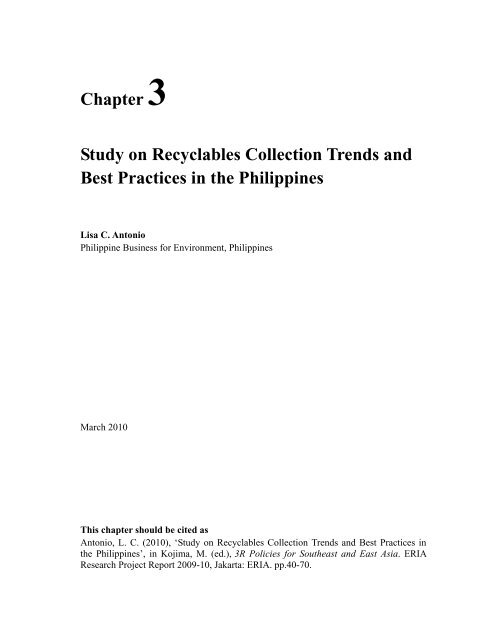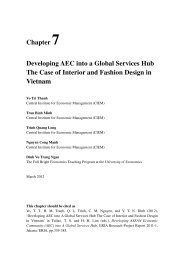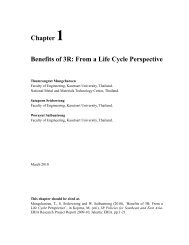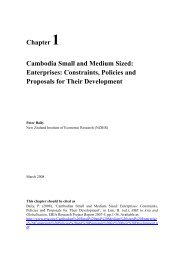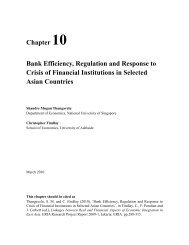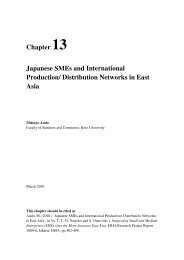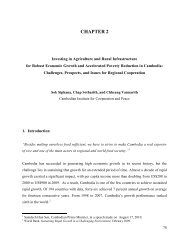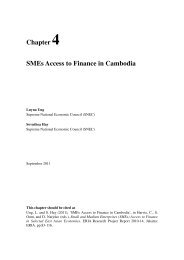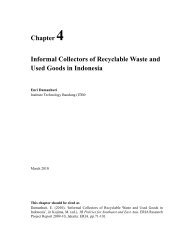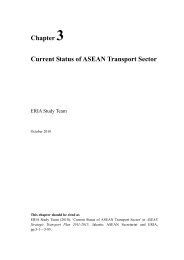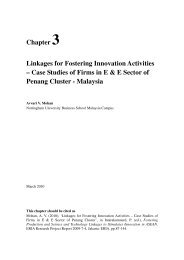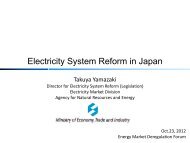Chapter 3 Study on Recyclables Collection Trends and Best ... - ERIA
Chapter 3 Study on Recyclables Collection Trends and Best ... - ERIA
Chapter 3 Study on Recyclables Collection Trends and Best ... - ERIA
You also want an ePaper? Increase the reach of your titles
YUMPU automatically turns print PDFs into web optimized ePapers that Google loves.
<str<strong>on</strong>g>Chapter</str<strong>on</strong>g> 3<str<strong>on</strong>g>Study</str<strong>on</strong>g> <strong>on</strong> <strong>Recyclables</strong> Collecti<strong>on</strong> <strong>Trends</strong> <strong>and</strong><strong>Best</strong> Practices in the PhilippinesLisa C. Ant<strong>on</strong>ioPhilippine Business for Envir<strong>on</strong>ment, PhilippinesMarch 2010This chapter should be cited asAnt<strong>on</strong>io, L. C. (2010), ‘<str<strong>on</strong>g>Study</str<strong>on</strong>g> <strong>on</strong> <strong>Recyclables</strong> Collecti<strong>on</strong> <strong>Trends</strong> <strong>and</strong> <strong>Best</strong> Practices inthe Philippines’, in Kojima, M. (ed.), 3R Policies for Southeast <strong>and</strong> East Asia. <strong>ERIA</strong>Research Project Report 2009-10, Jakarta: <strong>ERIA</strong>. pp.40-70.
CHAPTER 3<str<strong>on</strong>g>Study</str<strong>on</strong>g> <strong>on</strong> <strong>Recyclables</strong> Collecti<strong>on</strong> <strong>Trends</strong> <strong>and</strong> <strong>Best</strong> Practices in thePhilippinesLisa C. Ant<strong>on</strong>io 11 For the <strong>ERIA</strong> Research Project <strong>on</strong> 3R Policies in Southeast <strong>and</strong> East Asia, October 2009.40
1. Introducti<strong>on</strong>In the Philippines today, the annual solid waste generati<strong>on</strong> rate is about 10milli<strong>on</strong> t<strong>on</strong>s (36,000 cum), which translates to approximately 0.3 - 0.7 kg daily ofgarbage for each Filipino, which the World Bank estimates to grow by 40 percent bythe end of the decade (Philippine Envir<strong>on</strong>ment M<strong>on</strong>itor 2004, World Bank). Much ofthis is c<strong>on</strong>centrated in the urban areas where up to 44 percent of this waste isrecyclable. Recycling thus offers some of the most pragmatic soluti<strong>on</strong>s to reduce thevolume of generated waste.The Philippine Ecological Solid Waste Management Act of 2000, definesrecycling as “the treating of used or waste materials through a process of making themsustainable for beneficial use <strong>and</strong> for other purposes, <strong>and</strong> includes any process bywhich solid waste materials are transformed into new products in such a manner thatthe original products may lose their identity…” 2 It is differentiated from Reuse inwhich there is no alterati<strong>on</strong> of the physical or chemical characteristics of therecovered material.Though not yet quite a pervasive practice, organized recycling in thePhilippines has picked up in recent years. According to the Nati<strong>on</strong>al Solid WasteManagement Commissi<strong>on</strong> (NSWMC), recycling rates have been increasing,particularly in Metro Manila, from 6% in 1997; 13% in 2000; <strong>and</strong> 28% in 2006(Andin, Z; NSWMC, 2007) 3 . Am<strong>on</strong>g the major reas<strong>on</strong>s for this improvement are thefollowing: the implementati<strong>on</strong> of RA 9003, the grassroots SWM/ recyclingmovement, <strong>and</strong> the market forces.2. Drivers for RecyclingMany members of the older generati<strong>on</strong> claim that recycling is not new to theFilipino. This is true at the individual household level where food jars are reused, oldfurniture are refurbished/transformed to other uses, <strong>and</strong> even leftover lunch is“recycled” into new dinner fare. The advent of modern day lifestyles <strong>and</strong> a c<strong>on</strong>sumer2 Ecological Solid Waste Management Act of 2000 – Implementing Rules <strong>and</strong> Regulati<strong>on</strong>s ofRepublic Act 9003, Department of Envir<strong>on</strong>ment <strong>and</strong> Natural Resources – Envir<strong>on</strong>mentalManagement Bureau.3 Atty. Zoilo Andin, Jr., Executive Director, NSWMC. Philippine Nati<strong>on</strong>al Strategy <strong>on</strong> 3R, paperpresented at The 3R Workshop <strong>on</strong> Effective Waste Management <strong>and</strong> Resource se in SoutheastAsia, February 15, 2007, Asian Development Bank, Manila.41
c<strong>on</strong>venience– oriented society has however spawned a throw away mentality. Butrecycling is making a comeback.2.1. The Legal BasisOne of the reas<strong>on</strong>s for recycling is that the government has finally laid down aclear policy <strong>on</strong> solid waste management through the Republic Act 9003. This actessentially upgraded the cleanliness <strong>and</strong> anti–littering ordinances into a more cohesivenati<strong>on</strong>al law to deal with the growing garbage crisis in the country. It defined a 3RPolicy, Framework <strong>and</strong> Strategy for a systematic, comprehensive <strong>and</strong> ecological solidwaste management program based <strong>on</strong> the waste management hierarchy which, in anutshell, can be described as: Waste Avoidance, Reducti<strong>on</strong>, Reuse, Recycling,Treatment <strong>and</strong> Disposal (Andin, Z; NSWMC, 2007).The NSWMC, established under the Office of the President, is tasked tooversee the implementati<strong>on</strong> of SWM plans for which the lead agencies are the LGUs,starting with the barangays (i.e., the smallest unit of government at the village level).The LGUs are m<strong>and</strong>ated to develop their own Local Government SWM plans, based<strong>on</strong> the assessment of their local SWM situati<strong>on</strong> <strong>and</strong> a characterizati<strong>on</strong> of their waste.They are required to achieve an initial 25% waste diversi<strong>on</strong> target, through acombinati<strong>on</strong> of waste reducti<strong>on</strong>, recycling <strong>and</strong> composting programs.2.2. Grassroots SWM <strong>and</strong> Recycling MovementsWhile the law is not yet fully enforced <strong>and</strong> huge gaps exist with itsimplementati<strong>on</strong>, grassroots movements driven by local governments <strong>and</strong>envir<strong>on</strong>mental organizati<strong>on</strong>s have helped provide impetus for community–level wastesegregati<strong>on</strong>, collecti<strong>on</strong> <strong>and</strong> recycling activities. The Department of Envir<strong>on</strong>ment <strong>and</strong>Natural Resources (DENR) <strong>and</strong> the NSWMC lists fourteen government agencies <strong>and</strong>NGOs offering training <strong>on</strong> integrated solid waste management (ISWM) in its 2004ISWM Source Book for Local Government Units 4 . In additi<strong>on</strong> to this, the outreachactivities of LGU–ESWM units, corporate foundati<strong>on</strong>s, <strong>and</strong> envir<strong>on</strong>mental groupssuch as the Recycling Movement of the Philippines, the Solid Waste ManagementAssociati<strong>on</strong> of the Philippines (SWAPP), the Eco Waste Coaliti<strong>on</strong> <strong>and</strong> otherschool/church–based programs which c<strong>on</strong>duct advocacy activities for sustainable4 Integrated Solid Waste Management Source Book for Local Government Units, Volume 2:Organizati<strong>on</strong>s Offering Training <strong>on</strong> ISWM, DENR – Philippine Envir<strong>on</strong>mental GovernanceProgram, 2004.42
waste management <strong>and</strong> community–level programs also provide livelihoodopportunities from the transformati<strong>on</strong> of post–c<strong>on</strong>sumer waste into functi<strong>on</strong>al as wellas decorative items, like bags, belts, c<strong>on</strong>tainers/ baskets, desk items, bricks/ hollowblocks. There is no comprehensive listing available for smaller, local levelcounterparts operating in the regi<strong>on</strong>s who c<strong>on</strong>duct ISWM training <strong>on</strong> a c<strong>on</strong>tinuingbasis.2.3. Waste Trade <strong>and</strong> Market ForcesA 2008 Japan Internati<strong>on</strong>al Cooperati<strong>on</strong> Agency (JICA) <str<strong>on</strong>g>Study</str<strong>on</strong>g> <strong>on</strong> RecyclingIndustry Development in the Philippines 5 analyzed the macro scale material flow ofscrap paper (newspaper, cardboard), scrap metals (ir<strong>on</strong>, aluminum), glass bottles/cullets, scrap plastic <strong>and</strong> electr<strong>on</strong>ic/electrical waste (i.e. cellph<strong>on</strong>es, pers<strong>on</strong>alcomputers, junk TVs <strong>and</strong> refrigerators) for the period 2000–2004, using data from theDepartment of Trade <strong>and</strong> Industry (DTI) <strong>and</strong> the Bureau of Customs. The import/export trend <strong>and</strong> recycling rate for these recyclables are summarized in Table 1.The table above, shows high export volume for scrap ir<strong>on</strong>/ steel, despite highdomestic c<strong>on</strong>sumpti<strong>on</strong> requirements. This could be due to the relatively favorablebuying price of scrap metals in the regi<strong>on</strong>, although actual export earnings are notindicated. Export of waste plastic is also high, possibly because there was not enoughlocal capacity to recycle plastic during the period indicated. Hence the lowimportati<strong>on</strong> <strong>and</strong> recycling rate for waste plastic at <strong>on</strong>ly 8.4%. High importati<strong>on</strong> ofwaste paper <strong>and</strong> glass cullets help to meet the local recycling requirements which forpaper is at 41.2%; <strong>and</strong> for glass at 48.5%. Low import volume of aluminum scrap maysuggest that much of the aluminum recycling requirement scrap needed for localrecycling may come from finished or semi-finished products.Table 1. Macro Scale Material Flow of Selected <strong>Recyclables</strong>ImportVolume(t<strong>on</strong>s/yr)ImportCost(milli<strong>on</strong>Pesos)ExportVolume(t<strong>on</strong>s/yr)ExportEarnings(milli<strong>on</strong>Pesos)Domesticc<strong>on</strong>sumpti<strong>on</strong> ratet<strong>on</strong>s/yr(kg/cap/day)Currentrecyclingrate5 <str<strong>on</strong>g>Study</str<strong>on</strong>g> <strong>on</strong> Recycling Industry Development in the Philippines, Board of Investments –Department of Trade <strong>and</strong> Industry, <strong>and</strong> Japan Internati<strong>on</strong>al Cooperati<strong>on</strong> Agency, 2008 .43
Waste 388,553 2,446 7,542 51.6 1,559,510 0.049 41.2 %paperScrapnot 862,000 not 3,137,000 notnotir<strong>on</strong>/steel 22,000 givengivengiven givenScrapaluminum2,000 notgiven19,000 notgiven97,000 notgivennotgivenGlass 2919 33,9 73 8.1 427,192 0.013 48.5%culletWaste 14,900 194 44,476 676.7 691,911 0.022 8.4%plastic*note: figures for imported finished products from which some of the waste is derivedare not reflected in this table.Table 2, <strong>on</strong> the other h<strong>and</strong>, summarizes the major countries to which the recyclablewastes are exported to, or imported from.Table 2. <strong>Recyclables</strong> Trade for the Philippines 6Countries from which thePhilippines Imports <strong>Recyclables</strong>Waste paper Australia 22.7%Japan 17%Others: USA, HK, Germany,UAE, New Zeal<strong>and</strong>, Netherl<strong>and</strong>s,SingaporeScrap ir<strong>on</strong> China 51.3%Others: Taiwan, Palau, HK,ScrapaluminumSingapore, Korea, VN, JapanMalaysia, 38.1%; Korea 21.7%Others: China, Japan, Taiwan,India, Thail<strong>and</strong>, Singapore, HKGlass bottles China, 88%Others: Japan, Australia, Taiwan,Malaysia, UKWasteplasticGermany 33.7%,India 13.75, Japan 12.5%Others: S Korea, Netherl<strong>and</strong>s,S Africa, Singapore, Taiwan,USA, MalaysiaCountries to which the PhilippinesExports <strong>Recyclables</strong>Ind<strong>on</strong>esia 46.2%China 22.7%Singapore 10.2 %Others: VN, India, Thail<strong>and</strong>,Taiwan, South KoreaTaiwan 47%Thail<strong>and</strong> 14.2%, Singapore 13.8%Others: China, IndiaJapan 45.7%; UAE 27.7%Others: Singapore, China, VN,India, Thail<strong>and</strong>, Korea, Italy,AustraliaJapan 99.8% <strong>and</strong> UK 0.2%HK 44.8%China 35.2 %Others: Taiwan, Malaysia, SKorea, Tanzania, Nigeria, SAfrica, VN6 <str<strong>on</strong>g>Study</str<strong>on</strong>g> <strong>on</strong> Recycling Industry Development in the Philippines, Board of Investments –Department of Trade <strong>and</strong> Industry, <strong>and</strong> Japan Internati<strong>on</strong>al Cooperati<strong>on</strong> Agency, 200844
In most cases, the biggest export market of the Philippines for recyclablewastes appears to be to its neighbors in the regi<strong>on</strong>. Whereas the biggest source of itsimports for waste paper <strong>and</strong> waste plastic are Western countries.The global trade for recyclable material dipped c<strong>on</strong>siderably during theec<strong>on</strong>omic downturn in the past two years due to slowed down dem<strong>and</strong> frommanufacturers. Although this resulted in depressed buying prices <strong>and</strong> stockpiles ofrecyclables, the market has slowly begun to improve, <strong>and</strong> business has picked up forthose involved in various aspects of recyclables trading, such as collectors,c<strong>on</strong>solidators, bulk buyers, waste traders/ exporters.Aside from its global market potential, more successful community–basedrecycling programs have shown that there is really m<strong>on</strong>ey from recycling waste evenby the small entrepreneur, <strong>and</strong> that a smaller yet promising market exists for finishedproducts made from post–c<strong>on</strong>sumer waste. These entrepreneurs can take advantage ofexisting available technologies such as for laminates/ doy pack recycling, aluminumcan/ tetra pak recycling, tarpaulin recycling, mixed waste recycling (e.g. into hollowblocks/ bricks) <strong>and</strong> others. Sales outlets for finished products tend to be limited (e.g.regi<strong>on</strong>al trade fairs, eco– products fair) <strong>and</strong> that large–scale marketing <strong>and</strong>commercializati<strong>on</strong>, as well as quality c<strong>on</strong>trol, c<strong>on</strong>tinues to present challenges.3. Overview of the Recycling Market <strong>and</strong> Recycling IndustryThe 3Rs – Reduce, Reuse, Recycle – are strategies for dealing with generatedwaste, to reduce the volume that is needlessly thrown away <strong>and</strong> which takes up spacein l<strong>and</strong>fills. A sustainable SWM system however assumes that waste avoidance <strong>and</strong>reducti<strong>on</strong> is priority before the 3Rs. In the Philippines, more headway is beingachieved with the 3Rs than with waste avoidance since the latter requires an almostm<strong>on</strong>umental shift in paradigm of the Filipino society <strong>and</strong> of the industry as a whole.While not ideal, this is welcome n<strong>on</strong>etheless, as recycling in itself brings manybenefits.3.1. Types <strong>and</strong> volumes of household <strong>and</strong> commercial recyclablesIn Metro Manila, more than 50% of waste collected is organic/ biodegradable,<strong>and</strong> 44% is recyclable or factory–returnable. The latter is comprised mostly of scrap45
paper (19%), plastics (17%), ir<strong>on</strong>/metals (3%), aluminum (2%) glass (3%) <strong>and</strong> specialhazardous waste (1%). 7The JICA 2008 <str<strong>on</strong>g>Study</str<strong>on</strong>g> <strong>on</strong> Recycling Industry Development in the Philippinesprojected the volume of total recyclable materials based <strong>on</strong> its percentage in the wastestream, as follows:There are some variances with data from Mindanao in Southern Philippines,where five major types of recyclables are traded: glass, plastic, paper, lead acidbatteries <strong>and</strong> metals, with the latter as the largest in terms of volume traded as well asincome generated (i.e. 94% out of 70 junk shops included in a REECS survey). 8These, however, rarely come from households. Waste paper <strong>and</strong> plastics are the leasttraded <strong>and</strong> thus more likely to end up in the l<strong>and</strong>fills/ dumps, suggesting thatcollecti<strong>on</strong> <strong>and</strong> recycling opportunities for these materials (such as PET plastics)remain untapped.The volume of e-waste in the country (whether as post–c<strong>on</strong>sumer waste orimported as e–waste) is less discernable due to the abundance of cell ph<strong>on</strong>es, cellph<strong>on</strong>e batteries, pers<strong>on</strong>al computers/ computer parts brought in as sec<strong>on</strong>dh<strong>and</strong> items,through surplus shops or through the black market (i.e. smuggled). Major sources arefrom Japan, Korea, Taiwan, China, H<strong>on</strong>gk<strong>on</strong>g, United States, <strong>and</strong> Australia eitherlegitimately or illegally imported. 97 denr.gov.ph/nswmc/cbeswmp8 N. C. Lasmarias <strong>and</strong> R. S. Junio. "The Market for Recyclable Solid Waste Materials inMindanao," Resources, Envir<strong>on</strong>ment <strong>and</strong> Ec<strong>on</strong>omics Center, 2006.9 <str<strong>on</strong>g>Study</str<strong>on</strong>g> <strong>on</strong> Recycling Industry Development in the Philippines, Board of Investments –Department of Trade <strong>and</strong> Industry, <strong>and</strong> Japan Internati<strong>on</strong>al Cooperati<strong>on</strong> Agency, 2008.46
Table 3. <strong>Recyclables</strong> Projecti<strong>on</strong>, 2006–2010Materials % 2006 2008 2010Paper 19 3,601,317 3,856,274 4,129,280Plastic 17 3,222,231 3,450,350 3,694,619Ir<strong>on</strong> 3 568,629 608,885 651,992Aluminum 2 379,086 405,924 434,661* annual data given in t<strong>on</strong>sGlass 3 568,629 608,885 651,992Total 44 8,339,891 8,930,318 9,562,5443.2. Methods/ mechanics of collecti<strong>on</strong>: LGU Collecti<strong>on</strong> <strong>and</strong> VoluntaryCollecti<strong>on</strong> SchemesMunicipal solid waste from households is collected by garbage trucks eitherowned or c<strong>on</strong>tracted by the LGU through a bidding process. Waste are either disposedin the l<strong>and</strong>fills or brought to waste facilities where they may be further sortedmanually (by organized groups of scavengers as in the case of the Payatas, Clark <strong>and</strong>M<strong>on</strong>talban waste facilities) so that recyclables in the waste stream can be temporarilystored for eventual sale to private recyclers or for further processing or re- use. Themost comm<strong>on</strong> practice is house-to-house collecti<strong>on</strong> <strong>and</strong>/or curbside collecti<strong>on</strong> ofwastes placed in plastic bags or bins provided by the residents. Ir<strong>on</strong>ically, RA 2003has resulted in negative impact to the organized waste picker groups, due to reducedvolume of recyclables that reach the l<strong>and</strong>fill <strong>and</strong> thus lowered their income too. .Nevertheless, l<strong>and</strong>fill management is m<strong>and</strong>ated to fully implement the law, but socialpreparati<strong>on</strong> is needed to provide the waste pickers with alternative livelihoods whenthe l<strong>and</strong>fills/ dumpsites finally close.For some commercial–industrial waste, the collecti<strong>on</strong> service is tailored toindividual requirements using large trucks/c<strong>on</strong>tainers, or outsourced to accreditedwaste haulers. According to the NSWMC, average waste collecti<strong>on</strong> efficiency is 75%in urban areas <strong>and</strong> 40% in rural areas.47
Segregated waste, including recyclables, is either collected separately (in some areas)or by junk shop cooperatives/ eco–aides <strong>and</strong> brought to barangay/ city MRFs. TheMRF serves as a form of mini solid waste transfer or sorting stati<strong>on</strong>/ drop center,ideally having composting <strong>and</strong> recycling facilities. To date, there are 2,312 MRFsacross the country, as m<strong>and</strong>ated by RA 9003, with others still in the process of beingset up by the majority of barangays.Figure 1. Current Flow of <strong>Recyclables</strong> Collecti<strong>on</strong>MRFs<strong>Recyclables</strong>/CompostablesSource: <str<strong>on</strong>g>Study</str<strong>on</strong>g> <strong>on</strong> Recycling Industry Development in the Philippines, Board of Investments –Department of Trade <strong>and</strong> Industry, <strong>and</strong> Japan Internati<strong>on</strong>al Cooperati<strong>on</strong> Agency, 2008.At present, many informal, community-based <strong>and</strong> private sector collecti<strong>on</strong> <strong>and</strong>recycling projects also exist. The 2003 ADB <str<strong>on</strong>g>Study</str<strong>on</strong>g> surveyed existing community–based SWM activities in Metro Manila at that time. Its principal activities includedthe following: Recycling of n<strong>on</strong>–biodegradable materials; Composting of bio–degradable materials; <strong>and</strong> Livelihood Projects;48
Table 4. Surveyed CBSWM Initiatives, 2003 DENR-ADB SWM Project 10Voluntary waste collecti<strong>on</strong> schemes help to fill in the collecti<strong>on</strong> gap bycapitalizing <strong>on</strong> the ec<strong>on</strong>omic incentives to both waste generators <strong>and</strong> waste buyers<strong>and</strong> combining a business model with community livelihood projects. Many of theseschemes are launched by NGOs, often in partnership with LGUs, <strong>and</strong> intended not<strong>on</strong>ly to recover recyclables but also to increase envir<strong>on</strong>mental awareness throughpublic participati<strong>on</strong> <strong>and</strong> partnerships. The examples of these activities are as follows:3.2.1. For Household Collecti<strong>on</strong>oHouseholds to Junk Shops occur through LGU collecti<strong>on</strong> schemes which usemobile MRFs (in the city of Makati), or eco–aides (i.e., former streetscavengers or cart–pushers/ carit<strong>on</strong> boys who have been organized <strong>and</strong>accredited by barangays or by the Metro Manila Federati<strong>on</strong> of MultipurposeCooperatives under the Linis G<strong>and</strong>a Foundati<strong>on</strong> to collect recyclablematerials. The Federati<strong>on</strong> includes 17 individual member multipurposecooperatives representing the 17 local governments of Metro Manila; at least572 junk shops, 2,500 junk shop workers, 1200 eco- aides <strong>and</strong> 132 waste truckdrivers). 11 Outside Metro Manila, household collecti<strong>on</strong> is still most comm<strong>on</strong>ly10 Metro Manila Solid Waste Management Project, Department of Envir<strong>on</strong>ment <strong>and</strong> NaturalResources/ Asian Development Bank, September 2003.11 The Garbage Book - Solid Waste Management in Metro Manila, Department of Envir<strong>on</strong>ment<strong>and</strong> Natural Resources <strong>and</strong> the Asian Development Bank, 200449
d<strong>on</strong>e by individual cart–pushers who bring their collected recyclables to thejunk shops.oHouseholds to Junk Shops/ Recyclers occur through mall–based WasteMarkets/<strong>Recyclables</strong> Collecti<strong>on</strong> Fairs c<strong>on</strong>ducted regularly by two of thelargest mall operators in the country, the SM Supermalls <strong>and</strong> the Ayala Malls.At these Waste Markets/ <strong>Recyclables</strong> Fairs, buying stati<strong>on</strong>s/ covered tents areset up to receive scrap paper or cardboard/ plastics/aluminum or tin cans; usedink/ t<strong>on</strong>er cartridges, electr<strong>on</strong>ic waste/ “white” waste (such as junkappliances); <strong>and</strong> used lead acid batteries. Those who bring their recyclablesare paid <strong>on</strong> the spot for the assessed value, based <strong>on</strong> prevailing market prices.These Waste Markets are part of the Corporate Social Resp<strong>on</strong>sibility (CSR)programs of the malls, who voluntarily provide porti<strong>on</strong>s of their commercialparking areas for the venue. Malls do not derive any profit or commissi<strong>on</strong>from the participating junk shops/ recyclers. The Ayala Malls hold their<strong>Recyclables</strong> Fair every Friday <strong>on</strong> a rotating basis at five of their malls in theMetro Manila area. The SM Supermalls hold their Waste Markets under their“Trash to Cash” program every first Friday <strong>and</strong> Saturday of the m<strong>on</strong>th at their26 malls nati<strong>on</strong>wide. Since they began their Waste Markets in 2007/ 2008, theAyala Malls Group reported a collecti<strong>on</strong> of 46 t<strong>on</strong>s equivalent to P267,000.00,<strong>and</strong> the SM Supermalls has collected 417 t<strong>on</strong>s equivalent to P2.6 milli<strong>on</strong>.In additi<strong>on</strong>, annual <strong>Recyclables</strong> Collecti<strong>on</strong> Fairs are held <strong>on</strong> Earth Day (April22) <strong>and</strong>/or during Envir<strong>on</strong>ment M<strong>on</strong>th (June) in various parts of the country.These are part of envir<strong>on</strong>mental advocacy efforts of business groups/chambers of commerce/ companies (e.g. Davao City Chamber of Commerce,MetroBank Group/ Manila Doctors’ College, SMART Communicati<strong>on</strong>s,Rockwell L<strong>and</strong>/ Lopez Group of Companies, ABS–CBN BroadcastingNetwork) in partnership with the Philippine Business for the Envir<strong>on</strong>ment(PBE). To date, these <strong>Recyclables</strong> Collecti<strong>on</strong> Events (RCEs) have collected2336 cu m. of recyclable materials worth P3,434,769.67 since they began in2002, <strong>and</strong> channeled these to the local recycling industry. Extrapolatedenvir<strong>on</strong>mental benefits for the RCE collecti<strong>on</strong>s thus far, are as follows:50
Table 5. Summary of Envir<strong>on</strong>mental Benefits of RCEsRCE Envir<strong>on</strong>mental Benefits 2002-2009Number of trees saved: 3,154.20Lead recovered (kgs) 329,134.78Sulfuric acid treated (liters) 65,826.96Base metals recovered (kgs) 88,165.82Precious metals recovered (gms) 11,020.73Toxic substances treated: 14,694.30PET recovered (kgs) 6,502.76Aluminum recovered (kgs) 2,835.02Total L<strong>and</strong>fill space avoided (cu.m) 2,336.32Total Equivalent (10 t<strong>on</strong>) dump trucks 234Households to Manufacturing Companies –it mainly involves retrieval ofspecial waste like used lead acid batteries, old/ broken cellph<strong>on</strong>es / electr<strong>on</strong>icdevices, <strong>and</strong> used ink t<strong>on</strong>ers <strong>and</strong> cartridges.The Philippine Recyclers Inc. (PRI), the <strong>on</strong>ly ISO 14001 certified used leadacid battery recycling operati<strong>on</strong> in the Philippines, linked up in 2000 with then<strong>on</strong>-profit Bantay Kalikasan (Nature Watch) Foundati<strong>on</strong> <strong>and</strong> the DENR forthe Bantay Baterya (Battery Watch) program. This activity allows people toeither turn in their used batteries for new <strong>on</strong>es at a discounted rate, or tod<strong>on</strong>ate the trade–in value to the BK Foundati<strong>on</strong> for its envir<strong>on</strong>ment projects,such as watershed protecti<strong>on</strong> <strong>and</strong> anti–smoke belching. The Program aims “tosustain public awareness <strong>on</strong> the health <strong>and</strong> envir<strong>on</strong>mental hazards posed byindiscriminate junk battery disposal, provide a l<strong>on</strong>g –term mechanism forreducing the number of improperly disposed junk batteries, <strong>and</strong> ensure asteady supply of raw materials for the producti<strong>on</strong> of new batteries. It targets torecover 20% of the estimated 200,000 batteries c<strong>on</strong>sumed each m<strong>on</strong>thnati<strong>on</strong>wide, which goes underground to illegitimate smelters with limited leadrecycling capabilities <strong>and</strong> improper h<strong>and</strong>ling of battery acid <strong>and</strong> powder formlead. 12 As of 2008, a total of 400,000 kilos of used lead acid batteries <strong>and</strong>12 2008 Accomplishment Report, ABS CBN Foundati<strong>on</strong>. www.abs-cbnfoundati<strong>on</strong>.com51
60,000 litres of sulfuric acid have been recovered through Bantay Baterya.This has also avoided 586 m 3 of l<strong>and</strong>fill space.Companies such as Globe Telecommunicati<strong>on</strong>s, SMART Communicati<strong>on</strong>s<strong>and</strong> Nokia Philippines have also organized Used Cellph<strong>on</strong>e Collecti<strong>on</strong>Programs to enable the public to dispose their used units in cellph<strong>on</strong>ecollecti<strong>on</strong> bins in the malls <strong>and</strong> in Nokia Centers. These units are then shippedabroad for recycling. There is however competiti<strong>on</strong> with a thriving trade inused cellph<strong>on</strong>es by which <strong>on</strong>e can trade in an old unit for a newer model atover the counter cellph<strong>on</strong>e repair shops that proliferate in commercial centersthroughout the country <strong>and</strong> refurbish/ dismantle the old units for resale assec<strong>on</strong>dh<strong>and</strong> mobile ph<strong>on</strong>es.Ink Remanufacturers also abound in the cities nati<strong>on</strong>wide, offering to buyempty cartridges <strong>and</strong> t<strong>on</strong>ers for refill or resale, at stalls they set up in publicareas or during waste markets/ recyclable collecti<strong>on</strong> fairs.3.2.2. For School–based Collecti<strong>on</strong>o Schools to Junk Shops/ MRFs occur through <strong>on</strong>e–shot RCEs similar to the <strong>on</strong>ementi<strong>on</strong>ed above. This is initiated by student councils, faculty or parentassociati<strong>on</strong>s as part of their envir<strong>on</strong>ment awareness campaigns; or throughLGU-assisted c<strong>on</strong>tinuing schemes such as those by the Makati City, MarikinaCity <strong>and</strong> Quez<strong>on</strong> City governments.o In Makati City, all of its 29 public schools have established theirMRFs, <strong>and</strong> both public <strong>and</strong> private schools have partnered with theSan Miguel Corporati<strong>on</strong> for aluminum can <strong>and</strong> PET plastic bottlecollecti<strong>on</strong> for a total of close to 2 milli<strong>on</strong> pieces from 2006–2008. Thecity government also organized a “3B sa Pasko Program” (Bawasan,Balik – Gamitin at Baguhin ang Anyo/ Reduce- Recycle <strong>and</strong> reuse)working with schools <strong>and</strong> livelihood cooperatives to recycle waste intoholiday décor <strong>and</strong> gift items which are sold at Christmas bazaars. This52
has raised about P200,000 from 2006–2008 <strong>and</strong> diverted more than25,000 kg of garbage from the l<strong>and</strong>fill. 13oMarikina City’s Waste Management Office, in coordinati<strong>on</strong> with theDepartment of Educati<strong>on</strong>, introduced the Eco-Savers program in June2004. This requires students to bring recyclable garbage from theirrespective households during an assigned Eco Day—the day when thegarbage is going to be weighed <strong>and</strong> credited to their issued ecopassbooks. Each of the 18 public elementary schools in the city isassigned a <strong>on</strong>ce a week Eco Day.Accredited junk shops weigh the recyclables, record these in thepassbooks <strong>and</strong> haul all the recyclables collected. The recyclables arethen valued according to the prevailing market price <strong>and</strong> reflected inthe individual passbooks using a point system (PhP1.00 = 1 point).Points earned entitle the eco-saver to shop in the Eco-Savers MobileStore, which visits the school twice within the school year. This mobilestore carries educati<strong>on</strong>al materials such as dicti<strong>on</strong>aries, books, schoolsupplies <strong>and</strong> educati<strong>on</strong>al toys. An eco-saver <strong>on</strong>ly needs to present thepassbook to purchase school supplies. 14Records show that individual savings or points earned, within a schoolyear period, ranged from PhP50.00 to PhP1,800.00, which helpedreduce household expenses <strong>on</strong> school supplies. The Eco-Savers rogramhas also decreased the cost incurred in the disposal of local solid waste.The 50 truckload-trips a day to the dumpsite went down to an averageof 30 trips a day <strong>and</strong> has also c<strong>on</strong>tributed to traffic dec<strong>on</strong>gesti<strong>on</strong>, lessair polluti<strong>on</strong>, <strong>and</strong> energy c<strong>on</strong>servati<strong>on</strong>. Moreover, the program hasprovided junk shops within the city with a regular supply of recyclablematerials. Through this program, a total of 238,000 kilograms of wastewith a m<strong>on</strong>etary value of P1.3 milli<strong>on</strong> have been diverted fromdumpsites. In 2007, the Eco–Savers Program of Marikina wasrecognized with a Galing Pook (Good Governance) Award, a joint13 Villas, D., Department of Env Services, City Govt of Makati, Presentati<strong>on</strong> at SWAPCONN200814 www.galingpook.org/awardees/2007/2007_outst<strong>and</strong>ing_marikina.htm53
initiative of the Local Government Academy–Department of theInterior <strong>and</strong> Local Government (LGA-DILG), the Ford Foundati<strong>on</strong>,<strong>and</strong> other individual advocates of good governance from the academe,civil society <strong>and</strong> the government.o Schools with Manufacturing Companies – companies also partner with someschools to take back their used packaging/ discarded products in keeping withthe c<strong>on</strong>cept of Extended Producer Resp<strong>on</strong>sibility (EPR), as follows:o The Coca Cola Bottlers Philippines, Inc.: launched several school–based schemes in partnership with the Department of Educati<strong>on</strong>(DepEd) <strong>and</strong> the DENR for the collecti<strong>on</strong> of both aluminum cans <strong>and</strong>PET bottles, using redempti<strong>on</strong> schemes, school c<strong>on</strong>tests <strong>and</strong> trade–inprograms.One such previous program dubbed as “Give a Can, Give Hope”involved a tie up of the Coca Cola Bottlers Philippines, Inc. (CBPI)(for the widespread collecti<strong>on</strong> of aluminum cans) with the Departmentof Educati<strong>on</strong> <strong>and</strong> the WG&A shipping company which shipped thesecans from d<strong>on</strong>ors in the Visayas <strong>and</strong> Mindanao to Manila using itsSuperferry vessels. The cans were then turned over to the ReynoldsRecycling Corporati<strong>on</strong>, for c<strong>on</strong>versi<strong>on</strong> into aluminum tubings <strong>and</strong>sheets used for manufacturing low cost wheelchairs by the n<strong>on</strong>–profitTahanan Walang Hagdan / THC (House With No Steps) Foundati<strong>on</strong>for Pers<strong>on</strong>s with Disabilities (PWDs).Another program was an incentives scheme in which schools racked uppoints for every kilo of PET bottles collected, which they could swapfor school equipment (such as garden tools, school supplies, officeequipment such as copiers <strong>and</strong> computers) from a pre– prepared menuof items. However, both Programs <strong>on</strong>ly ran for a limited period <strong>and</strong>were disc<strong>on</strong>tinued after CCBPI turned over the collecti<strong>on</strong> process toaccredited c<strong>on</strong>solidators.oTetra Pak Philippines tied up with the n<strong>on</strong>–profit Linis G<strong>and</strong>aFoundati<strong>on</strong> for the collecti<strong>on</strong> of used tetra pak cart<strong>on</strong>s; <strong>and</strong> has also54
d<strong>on</strong>ated collecti<strong>on</strong> bins to about 100 partner schools for pre– arrangedpick up by c<strong>on</strong>solidators for delivery to partner paper manufacturerssuch as the Trans Nati<strong>on</strong>al Paper Corp which recycle these intocomposite boards. These boards are either d<strong>on</strong>ated to Habitat forHumanity Philippines to be used as doors/ furniture for housing units,or given to THC whose resident craftsmen turn these into furniture,home <strong>and</strong> office accessories <strong>and</strong> gift items. The schools which collectthe most volume of used tetra pak cart<strong>on</strong>s are awarded cash prizes orchipboard items. Tetra Pak also partners with Global Paper Corp torecycle the used cart<strong>on</strong>s into brown paper. 153.2.3. For Commercial/ Business Collecti<strong>on</strong>Companies to Junk Shops: The Ayala Foundati<strong>on</strong>, which is the corporatefoundati<strong>on</strong> arm of the Ayala Group of companies, initiated a PartnershipProject with Junkshops in Makati City where it owns <strong>and</strong> leases out 26commercial <strong>and</strong> residential buildings. They partnered with the Metro ManilaFederati<strong>on</strong> of Envir<strong>on</strong>ment Multi-Purpose Cooperatives (MMFEMPC) whichdesignated authorized junk shop members to collect recyclable materials fromspecific assigned cluster of buildings using 4-wheel vehicle such as jeep orpick-up at specified hours. Use of carts <strong>and</strong> pedicabs was strictly prohibited.Collectors are required to wear T- shirt uniforms provided for them, carry dulysigned authorizati<strong>on</strong> papers, <strong>and</strong> attend m<strong>on</strong>thly progress update meetings.Building managers kept a detailed record of collecti<strong>on</strong> days <strong>and</strong> volumes, <strong>and</strong>payment for collected recyclable materials is d<strong>on</strong>e <strong>on</strong> a cash basis using ast<strong>and</strong>ard minimum price list that was regularly updated. The Programorganized training <strong>and</strong> orientati<strong>on</strong>s for both the Building Managers <strong>and</strong>MMFEMPC members, <strong>and</strong> resulted in the publicati<strong>on</strong> of a SWM Instructi<strong>on</strong>alManual for Building Administrators. 16oCompanies to NGOs - as part of their CSR, many companies have found waysto deal with wastes from their marketing activities like banners <strong>and</strong> tarpaulins,15 www.tetrapak.com.16 Licos, A. Building Partnerships with Junk Shops. Presentati<strong>on</strong> at SWAPCONN 2008.55
while at the same time providing livelihood opportunities for communities <strong>and</strong>NGOs who turn these into functi<strong>on</strong>al materials like shopping bags, folders <strong>and</strong>envelopes. Examples of these tie ups are: Globe Telecommunicati<strong>on</strong>s toBantay Kalikasan, SMART Communicati<strong>on</strong>s <strong>and</strong> the Earth Day Network;Unilever Philippines <strong>and</strong> the Smoky Mountain Foundati<strong>on</strong>, Cebu FurnitureIndustries with RIBA/ Recycling Initiative of Bais City (Negros Oriental);Ayala Corp <strong>and</strong> Shangri – la Hotels with the Gifts <strong>and</strong> Graces Foundati<strong>on</strong>. Thelatter, for example, aims to “improve the quality of life of marginalizedmembers of society by providing product development <strong>and</strong> global marketaccess to livelihood communities under the Gifts <strong>and</strong> Graces br<strong>and</strong>.”Companies to companies: Since 1996, the PBE has been managing theIndustry Waste Exchange Program (IWEP), which operates as an Informati<strong>on</strong>Clearinghouse that matches waste generators <strong>and</strong> waste buyers, <strong>and</strong> promotesresource recovery through orientati<strong>on</strong> sessi<strong>on</strong>s, company in–house seminars,Envir<strong>on</strong>mental exhibit/ trade fairs, case studies /publicati<strong>on</strong>s, Waste Markets<strong>and</strong> RCEs, <strong>and</strong> IWEP ads in its quarterly Business <strong>and</strong> Envir<strong>on</strong>mentMagazine. Manpower c<strong>on</strong>straints make it difficult to track all possible wasteexchange referrals, or offer services bey<strong>on</strong>d referrals <strong>and</strong> promoti<strong>on</strong>.Nevertheless, there have been several documented case studies of successfulwaste exchanges also being implemented as a geographic – specific programby the Davao City Chamber of Commerce <strong>and</strong> Industry in the Mindanao area,<strong>and</strong> the Eco-Industrial Exchange Network (Eco – Index) of industrial estatesin the Laguna- Batangas area (north of Manila).3.3. Recycling Technologies <strong>and</strong> FacilitiesUp<strong>on</strong> reaching the recycling facility, the recyclables are transformed intouseful raw materials or finished products through a variety of locally availabletechnologies. There are large recycling facilities for paper, plastics, used lead acidbatteries, scrap metals, electr<strong>on</strong>ics waste <strong>and</strong> glass. Cement plants also collect usedtires for use as substitute fuel for their kilns (i.e. co–processing). Smaller, communityrecycling that are less capital–intensive also occur for laminates (“doy” packs)recycling <strong>and</strong> spent ink <strong>and</strong> t<strong>on</strong>er cartridges. The Department of Science <strong>and</strong>Technology (DOST) – Industrial Technology Development Institute (ITDI) has56
helped to promote many of these technologies with help from the ADB. Otherresiduals are processed into n<strong>on</strong> – load bearing c<strong>on</strong>crete materials (e.g. hollow blocks,benches, perimeter walls, traffic barriers) – palingenesis, hydromex technologies. 17New business opportunities have resulted in more envir<strong>on</strong>ment serviceproviders for the treatment of special <strong>and</strong> hazardous materials such as fluorescentlamps <strong>and</strong> bulbs <strong>and</strong> industrial waste like sludge <strong>and</strong> spent solvents. However, there isstill much room for expansi<strong>on</strong> here, <strong>and</strong> treatment costs are not always within thereach of smaller companies, especially those in the regi<strong>on</strong>s outside of Metro Manila /Luz<strong>on</strong> where such facilities may be sparse or n<strong>on</strong>–existent. Thus, the uptake for theseenvir<strong>on</strong>ment technologies needs to be hastened through informati<strong>on</strong> sharing, technical<strong>and</strong> financial assistance, incentives <strong>and</strong>, most importantly, political will.A Recyclers’ Directory at the NSWMC website lists 56 recyclers as follows:Table 6. Recyclers Locati<strong>on</strong>s (based <strong>on</strong> NSWMC database) 18Type of <strong>Recyclables</strong>Plastics(HDPE, LDPE, PP,PS, PET, HIPS,PVC, OthersPaper(newsprint, officepaper, other Whitegrades, corrugatedcart<strong>on</strong>s, paperboxes)No. ofRecyclers 19Locati<strong>on</strong>s(in Luz<strong>on</strong> / aroundMetroManila)24 Valenzuela (14)Manila (2)Quez<strong>on</strong> City (2)CaloocanLagunaM<strong>and</strong>aluy<strong>on</strong>gMuntinlupaParañaque14 Makati (2)Pasig (2)Quez<strong>on</strong> City (2)CaloocanCaviteLagunaMalab<strong>on</strong>MarikinaPampangaLocati<strong>on</strong>s(other thanMetroManila/ Luz<strong>on</strong>)CebuDavao17 www. denr.gov.ph; www.dost.gov.ph18 www.denr.gov.ph/nswmc.19 The PBE database lists 1 additi<strong>on</strong>al PET recycler in Pampanga, 2 additi<strong>on</strong>al electr<strong>on</strong>icsrecyclers in Bulacan <strong>and</strong> Caloocan; <strong>and</strong> <strong>on</strong>e additi<strong>on</strong>al tin can recycler.57
ParañaqueUsed Lead Acid1 BulacanBatteriesComputers/1 LagunaElectr<strong>on</strong>icsTin Cans 1 M<strong>and</strong>aluy<strong>on</strong>gMetals 2 CaviteQuez<strong>on</strong> CityC<strong>on</strong>tainer Glass 6 Cavite (2)CebuLagunaMakatiManilaFlat Glass 1 PasigTetra Pak* usually also by paper recyclersTires 6 BulacanLas PiñasManilaMarikinaPasigQuez<strong>on</strong> CityTotals 56 53 3Note: Some locati<strong>on</strong>s (e.g. Makati) are those of headquarters rather than plant facilities.The locati<strong>on</strong>s are visually depicted in the map below:Figure 2. Locati<strong>on</strong> Map of Recyclers (from NSWMC database) - PhilippinesMetroManila/Luz<strong>on</strong> (53)Cebu (2)Davao (1)The 2003 ADB Metro Manila SWM <str<strong>on</strong>g>Study</str<strong>on</strong>g> however states that there are about<strong>on</strong>e hundred recycling companies <strong>and</strong> organizati<strong>on</strong>s in Metro Manila al<strong>on</strong>e, with58
Valenzuela City in the Bulacan province (north of Manila) having the largestc<strong>on</strong>centrati<strong>on</strong> (as similarly reflected in the NSWMC database), mostly of plasticsrecylers. 20 This excludes junk shop operati<strong>on</strong>s which do more of waste segregati<strong>on</strong><strong>and</strong> trade rather than <strong>on</strong>–site recycling, with little investments in equipment,technology or trained pers<strong>on</strong>nel.Some of these recyclers may have collecti<strong>on</strong> agents in the regi<strong>on</strong>s. However,the costs of transportati<strong>on</strong> <strong>and</strong> shipping of recyclables from the provinces to MetroManila where the recycling plants are located, can be a deterrent to sustainedrecycling programs in these areas. Also, many of the local recycling industries, inparticular of paper, scrap metal, plastics are faced with stiff competiti<strong>on</strong> in the foreignmarket, especially China, which imports these at higher buying prices, <strong>and</strong> devourssuch materials to meet the dem<strong>and</strong>s of their growing ec<strong>on</strong>omy.4. Stakeholder RolesFrom the reports menti<strong>on</strong>ed above, we can summarize the variousstakeholders in the recycling sector as follows:ooooC<strong>on</strong>sumers/Instituti<strong>on</strong>al & Commercial Waste Generators – whetherhouseholds; instituti<strong>on</strong>s like schools, offices; commercial/ businessestablishments including restaurants <strong>and</strong> malls where large numbers of peopletend to c<strong>on</strong>gregate;Collectors/ C<strong>on</strong>solidators - whose role is to collect the waste generated atvarious collecti<strong>on</strong> points;LGUs - who are m<strong>and</strong>ated by law to implement efficient SWM programs <strong>and</strong>to promote the 3Rs to achieve the minimum required waste diversi<strong>on</strong> rate; <strong>and</strong>to enact <strong>and</strong> enforce the necessary local ordinances <strong>and</strong> policies to ensurecompliance by domestic <strong>and</strong> commercial establishments;Producers/ Manufacturers – with the potential to help reduce waste throughproduct/ packaging redesign; ec<strong>on</strong>omic incentives, take back programs <strong>and</strong>process changes;20 Metro Manila Solid Waste Management Project, Department of Envir<strong>on</strong>ment <strong>and</strong> NaturalResources/ Asian Development Bank, September 2003.59
oooBuyers/ Traders – who take advantage of domestic <strong>and</strong> global market forces totrade recyclables that can be used as raw material by major manufacturingindustries;Recyclers – who invest in the technologies, facilities <strong>and</strong> infrastructure tomake recycling a viable industry using a business model approach; <strong>and</strong>Envir<strong>on</strong>mental/ Recycling Organizati<strong>on</strong>s/ Associati<strong>on</strong>s - who mount advocacyprograms <strong>and</strong> informati<strong>on</strong> programs to increase general awareness <strong>on</strong> thebenefits of recycling <strong>and</strong> generate public support <strong>and</strong> participati<strong>on</strong>; <strong>and</strong> whoinitiate/ provide technical assistance for community–based livelihoodprograms.Using the SWM hierarchy as a guiding framework, the most preferredbehavior is for c<strong>on</strong>sumers <strong>and</strong> waste generators to avoid creating waste by reducing atsource (e.g. of packaging, leftovers, over spending <strong>on</strong> c<strong>on</strong>sumer goods), <strong>and</strong> thensubsequently segregating/ sorting waste into reusables/ recyclables / n<strong>on</strong> –recyclables, for which barangays establish MRFs where further manual sorting takesplace. LGUs have the direct resp<strong>on</strong>sibility for collecti<strong>on</strong> of waste bound for thel<strong>and</strong>fills, <strong>and</strong> for building treatment <strong>and</strong> disposal facilities for residuals.Municipalities/ cities (or, in the case of Metro Manila, the Metro Manila DevelopmentAuthority). These roles are summarized in the figure below:60
Figure 4 Stakeholder Roles <strong>and</strong> Resp<strong>on</strong>sibilities in the Solid Waste ManagementHierarchy (NSWMC)Partnership enterprises as dictated by policy,ec<strong>on</strong>omies of scale <strong>and</strong> in partnership with LGUsMunicipalities/ CitiesDirect Resp<strong>on</strong>sibilityAvoidReduceReuseRecycleRecoverTreatmentResiduals ManagementSWM HierarchyFirstpreferredopti<strong>on</strong>sLastpreferredopti<strong>on</strong>sInfluencing Resp<strong>on</strong>sibility5. C<strong>on</strong>tinuing Issues <strong>and</strong> Less<strong>on</strong>s LearnedThere are issues <strong>and</strong> c<strong>on</strong>cerns for the recycling industry as a whole <strong>and</strong> foreach specific type of recyclable materials.5.1. The general c<strong>on</strong>cerns of the recycling industry includeo Lack of c<strong>on</strong>sistent enforcement of envir<strong>on</strong>mental laws, allowing unregistered<strong>and</strong> unregulated competiti<strong>on</strong> from informal recyclers who not <strong>on</strong>ly unfairlycompete with legitimate investors <strong>and</strong> businessmen, but also pose publichealth <strong>and</strong> safety risks in areas where they operate, particularly with respect tospecial recyclable wastes like electr<strong>on</strong>ic / electrical waste;o Absence of clear market data for the regi<strong>on</strong>s, recycling facilities tend to bec<strong>on</strong>centrated in Metro manila or Luz<strong>on</strong> urban areas, making it difficult to61
ooosustain recycling programs in the provinces due to the large transportati<strong>on</strong>/shipping costs;Vulnerability of prices to world market fluctuati<strong>on</strong>s brought about by globalec<strong>on</strong>omic situati<strong>on</strong>; <strong>and</strong> competiti<strong>on</strong> between the export market <strong>and</strong> the localrecycling market sometimes leading to a decrease in locally availablerecyclables as producti<strong>on</strong> input for the local recyclers, notably with paper,scrap ir<strong>on</strong>/ metals <strong>and</strong> PET plastics;Lack of clear industry st<strong>and</strong>ards for recyclables – e.g. though tetra pak are74% food grade paper board (4% aluminum, <strong>and</strong> 22% others), most paperrecyclers remove them from the scrap paper pile, <strong>and</strong> they end up virtuallydiscarded thus adding to the SW problem <strong>and</strong> losing out <strong>on</strong> commercialopportunities; <strong>and</strong>Lack of investments to upscale/ commercialize some of the recyclingtechnologies to bring down costs, such as for recycling of tetra pak cart<strong>on</strong>sinto fiberwood.5.2. Some c<strong>on</strong>cerns of selected recycling industry sectors are5.2.1. PaperoooFor many existing paper millers, there is need to update old orinefficient equipment <strong>and</strong> machinery; <strong>and</strong> to adapt newer technology(e.g. for the recycling of Tetra Pak into cart<strong>on</strong>/ cardboard);Related to the above c<strong>on</strong>cern is also the higher costs of water <strong>and</strong>electricity in relati<strong>on</strong> to the efficiency of the equipment, as well as theoperati<strong>on</strong>s itself; <strong>and</strong>Domestic paper collecti<strong>on</strong> still needs to be improved, especially in theregi<strong>on</strong>s, not <strong>on</strong>ly with respect to volume but also with the h<strong>and</strong>lingprocess to ensure the quality of the used paper supply for theproducti<strong>on</strong> of new paper (<strong>and</strong> to minimize “c<strong>on</strong>taminati<strong>on</strong>” with othermixed waste).5.2.2. Plasticso The use of scrap plastic for plastic producti<strong>on</strong> is very low compared tothat of paper, glass <strong>and</strong> metals. Hence, waste plastics comprise a majorpart of the waste stream throughout the country. In part, this is due to62
oothe difficulty of separating plastic waste from mixed waste, for whichmore public educati<strong>on</strong> is needed;On the other h<strong>and</strong>, some types of plastic waste such as PET bottles, arebeing exported in large quantities where they fetch higher buyingprices, thus affecting the local supply of the local plasticsmanufacturers; <strong>and</strong>For processing of PVC scraps to produce PVC flakes, there are sometechnology limitati<strong>on</strong>s (e.g. need to manually sort 28 types of scraps ofPVC before crushing/ shredding); <strong>and</strong> no suitable size of extruder).5.2.3. Metalso There is severe competiti<strong>on</strong> between local scrap metals buyers (e.g. forir<strong>on</strong>, tin <strong>and</strong> aluminum) <strong>and</strong> the buyers for foreign markets due to thelarge export dem<strong>and</strong> <strong>and</strong> higher export prices for them;o The materials is also highly vulnerable to extreme price fluctuati<strong>on</strong>s;<strong>and</strong>o Higher operating costs for local metals recycling result from the highcost of electricity (for electric furnaces in steel making), <strong>and</strong> shipping/transport.5.2.4. GlassooScrap glass fetches comparatively lower prices than the otherrecyclables due to its h<strong>and</strong>ling bulk (thus requiring large collecti<strong>on</strong> <strong>and</strong>storage areas); wide range of specificati<strong>on</strong>s (e.g. color, thickness,opacity); <strong>and</strong> high transport cost; <strong>and</strong>In the Philippines, there are also few glass recyclers <strong>and</strong> domestic usersof scrap glass. Existing <strong>on</strong>es tend to be c<strong>on</strong>centrated in <strong>on</strong>e area (i.e.,Laguna).5.2.5. Used Lead acid batterieso Informal backyard ULAB recyclers abound, creating unfair <strong>and</strong>unregulated competiti<strong>on</strong> to the legitimate business investor, giving theULAB industry a negative image, as well as posing public health <strong>and</strong>safety risks. Also, despite ISO 14001 certificati<strong>on</strong> <strong>and</strong> strict63
importati<strong>on</strong> guidelines <strong>and</strong> m<strong>on</strong>itoring protocols by the DENR, somelocal envir<strong>on</strong>mental NGOs c<strong>on</strong>tinue to oppose the importati<strong>on</strong> of usedlead acid batteries which can affect the optimal operating capacity ofthe ULAB recycling facility. PRI’s tie–up with both the DENR <strong>and</strong> theBantay Kalikasan (BK) has helped lend a measure of credibility totheir ULAB retrieval program <strong>and</strong> influence positive public percepti<strong>on</strong>,to some degree.5.2.6. Electr<strong>on</strong>ic Wasteo The sector is poorly regulated <strong>and</strong> many backyard operati<strong>on</strong>s existwhich create problems for worker health, community safety <strong>and</strong>envir<strong>on</strong>mental c<strong>on</strong>taminati<strong>on</strong>. This also gives the industry a badreputati<strong>on</strong>, to the detriment of the legitimate recyclers;o Many mall – based electr<strong>on</strong>ics retail / repair shops are based in malls<strong>and</strong> commercial shopping centers that have no e- waste segregati<strong>on</strong>;thus resulting in their inclusi<strong>on</strong> with mixed waste. Very few (possiblyn<strong>on</strong>e) have generalized or bulk disposal systems (e.g. for cell ph<strong>on</strong>ebattery wastes or n<strong>on</strong> – working units/ parts). In areas outside MetroManila, disposal is via municipal waste, open dumping or burial,which makes retrieval difficult;o While the e- waste stream is increasing in the country (e.g. junkcomputers <strong>and</strong> cellph<strong>on</strong>es/ cellph<strong>on</strong>e batteries), collecti<strong>on</strong> is hamperedby the Filipino penchant to retain their old units for their perceived“residual” value or to pass these <strong>on</strong> to other users when they upgradetheir own; <strong>and</strong>o More public awareness is needed <strong>on</strong> the hazardous materials in theseequipment <strong>and</strong> the need for proper recycling <strong>and</strong>/or disposal.6. Recommendati<strong>on</strong>sRecycling in the Philippines is in a relatively infant stage, but has a largepotential for growth if the various stakeholders examine the less<strong>on</strong>s learned from theindustry’s experience or achievement so far.64
For the collecti<strong>on</strong> process, in particular, this study suggests the followingrecommendati<strong>on</strong>s:6.1. Improving the collecti<strong>on</strong> volumeo Although the collecti<strong>on</strong> schemes today are better organized today thanin the past, LGUs should c<strong>on</strong>tinue to support <strong>and</strong> strengthen theexisting informal networks of collectors/ junkshops/ waste pickers as asec<strong>on</strong>dary materials recovery system, for both envir<strong>on</strong>mental <strong>and</strong>social reas<strong>on</strong>s. The experiences of Payatas, Clark <strong>and</strong> Quez<strong>on</strong> City, aswell of private sector schemes like those of the Ayala Groupdem<strong>on</strong>strate that such successful schemes help to alleviate both thegarbage problem <strong>and</strong> the collecti<strong>on</strong> burden of LGUs without additi<strong>on</strong>alcosts to the taxpayer.o The success of voluntary collecti<strong>on</strong> schemes, especially those jointlyorganized by the LGUs, private sector <strong>and</strong> NGOs, dem<strong>on</strong>strate thatpractical, c<strong>on</strong>venient channels are needed to encourage moreparticipati<strong>on</strong> from the public. Some of these schemes offer m<strong>on</strong>etaryincentives (such as trade–in value, or points –systems). Others offern<strong>on</strong>–tangible incentives (e.g. protecting the envir<strong>on</strong>ment) such aspolystyrene/ cellph<strong>on</strong>e collecti<strong>on</strong> which does not give m<strong>on</strong>etaryincentives.o A comm<strong>on</strong> denominator for successful collecti<strong>on</strong> appears to be withthe use of widespread promoti<strong>on</strong>s which includes the benefits ofrecycling <strong>and</strong> feedback to the public of the value of their c<strong>on</strong>tributi<strong>on</strong>s;accessibility (e.g. at malls, schools or public places) <strong>and</strong> reliability (i.e.regular collecti<strong>on</strong>/ redemptioin schedules). Thus, collecti<strong>on</strong> channelsshould be well– publicized.o In additi<strong>on</strong>, more such collecti<strong>on</strong> points / collecti<strong>on</strong> sites need to be setup in places outside Metro Manila, although this, of course, can beseriously limited by the locati<strong>on</strong> of the recycling facilities themselves,due to the prohibitive costs of transporting the recyclable goods.65
6.2. Improving the collecti<strong>on</strong> processoooIt is equally important to provide proper guidance <strong>and</strong> training, to junkshops <strong>and</strong> sec<strong>on</strong>dary level collectors <strong>on</strong> the proper h<strong>and</strong>ling ofrecyclable materials to assure better quality of the supply to therecycling industries, <strong>and</strong> avoid rejects. Thus, guidelines are needednot <strong>on</strong>ly for recycling but also for collecti<strong>on</strong>. These can be developedin c<strong>on</strong>sultati<strong>on</strong>/ with the help of the different stakeholders.Assistance for start–up financing from the government or privatesector (e.g. for small trucks, warehouses/ collecti<strong>on</strong> stati<strong>on</strong>s, payroll)would also help encourage small collecti<strong>on</strong> businesses.Collectors <strong>and</strong> c<strong>on</strong>solidators appear capable of quickly networkingwith waste buyers <strong>and</strong> recyclers, but government can still providefurther help in establishing market linkages, especially for new suchopportunities in the regi<strong>on</strong>sSince the underlying assumpti<strong>on</strong> for improving collecti<strong>on</strong> is that the market forrecyclables will c<strong>on</strong>tinue to grow, the current study also offers somerecommendati<strong>on</strong>s for improving recycling practices as a whole.oooNeed for more reliable <strong>and</strong> comprehensive informati<strong>on</strong> <strong>on</strong> therecyclables market, especially to attract more private sector investmentto build recycling facilities or to commercialize recycling technologies;Importance of meeting envir<strong>on</strong>mental st<strong>and</strong>ards <strong>and</strong> of highlightinggood industry practices - Recycling industries are generally perceivedto be “dirty” <strong>and</strong> “unsanitary” in part because some did start out assuch <strong>and</strong> many informal activities c<strong>on</strong>tinue to operate. But newtechnologies <strong>and</strong> appropriate skills training can elevate recycling into arespectable industry, <strong>and</strong> the ec<strong>on</strong>omic <strong>and</strong> envir<strong>on</strong>mental benefitsthey offer should be highlighted by the industry. Having local industryst<strong>and</strong>ards as well can improve the export chances of local recyclablematerials;Importance of improving enforcement <strong>and</strong> regulati<strong>on</strong>, to level theplaying field <strong>and</strong> encourage legitimate investments in envir<strong>on</strong>mentally66
safe, proper recycling operati<strong>on</strong>s; as well as to protect existinglegitimate <strong>and</strong> envir<strong>on</strong>mentally compliant investors;o Promoting community – level adopti<strong>on</strong> <strong>and</strong> technology transfer ofrecycling technologies - examples of successful community – levelcollecti<strong>on</strong> <strong>and</strong> recycling efforts cited in this paper had a good start withsupport from foreign assisted d<strong>on</strong>or projects which helped to establishthe proper community–level structure, initial funding, technicalassistance/ technology transfer <strong>and</strong> documentati<strong>on</strong> of the project toserve as replicable models in other parts of the country. Theavailability of relatively newly developed recycling technologieswhich are not capital–intensive (such as doy pack/ laminates / mixedwaste recycling into chipboards/ hollow blocks) created dem<strong>and</strong> forwaste materials that would otherwise merely have been discarded;o Policy incentives <strong>and</strong> Ec<strong>on</strong>omic incentives to recycling industries –Experience from other countries suggest that having nati<strong>on</strong>al recyclingtargets can significantly boost the growth of recycling efforts <strong>and</strong>investments. In additi<strong>on</strong>, some of the existing recycling facilitiesbenefited from pi<strong>on</strong>eer status accorded them by the Board ofInvestments (BOI) of the Department of Trade <strong>and</strong> Industry (DTI) toallow them to bring in equipment with lower/ no tax; <strong>and</strong> enjoy a taxholiday for initial years of operati<strong>on</strong> to be able to establish a foothold<strong>and</strong> recover some of their initial capital investment;o Partnership with other stakeholders – notably government (e.g.DOST/ DENR/ LGUs) <strong>and</strong> reputable NGOs (e.g. PBE/ BK) to helpadd credibility to company recycling efforts/ envir<strong>on</strong>mental programs,with the added benefit of having an advocacy/ educati<strong>on</strong> objective <strong>and</strong>,where possible, to find ways to integrate the informal sector so as toavoid social displacement <strong>and</strong> livelihood loss;o Organized effort by the recycling industry- Local recycling industriescan b<strong>and</strong> together <strong>and</strong> form a professi<strong>on</strong>al associati<strong>on</strong> that can dialoguewith government <strong>and</strong> other stakeholders, educate the public <strong>on</strong> thebenefits of industry recycling <strong>and</strong> pursue programs to promote supportfor the recycling industry as a whole; <strong>and</strong>67
oStimulating dem<strong>and</strong> for recycled products <strong>and</strong> promoting benefits ofpost–c<strong>on</strong>sumer recycled products – provides a larger market forrecycling businesses <strong>and</strong> encourages the growth of more eco–entrepreneurs, noting that in the Philippines, as in many othercountries, more than 90% of industry is small <strong>and</strong> medium in size. Thesuccess of the most recent eco–products fair held in Manila in early2009, with plans already afoot for another <strong>on</strong>e in 2010, suggest thatthese, combined with green procurement programs, are effectivevehicles for generating interest <strong>and</strong> support for eco products, includingrecycled products. The government can further stimulate dem<strong>and</strong> byenacting policy in favor of green public procurement. An example isthe Executive Order 301, issued by the Office of the President inMarch 2004, requiring all departments, bureaus, offices <strong>and</strong> agenciesof the executive branch to establish their Green Procurement Programs.Although implementati<strong>on</strong> has been slow, <strong>on</strong>e outcome of this is theinclusi<strong>on</strong> of envir<strong>on</strong>mentally preferred criteria in the procurementguidelines of the Department of Budget <strong>and</strong> Manage68
ReferencesABS CBN Foundati<strong>on</strong>. 2008 Accomplishment Report,. www.abs-cbnfoundati<strong>on</strong>.com.Andin, Jr. Zoilo., Executive Director, NSWMC. Philippine Nati<strong>on</strong>al Strategy <strong>on</strong>3R, paper presented at The 3R Workshop <strong>on</strong> Effective Waste Management <strong>and</strong>Resource se in Southeast Asia, February 15, 2007, Asian Development Bank,Manila____________________________.Ant<strong>on</strong>io, Lisa A. <str<strong>on</strong>g>Study</str<strong>on</strong>g> <strong>on</strong> 3R Policy <strong>and</strong> Waste Exchange in the Philippines, EastAsia Research Project for 3R Policies in Southeast <strong>and</strong> East Asia, 2009.Board of Investments- Department of Trade <strong>and</strong> Industry (BOI-DTI) <strong>and</strong> JapanInternati<strong>on</strong>al Cooperati<strong>on</strong> Agency (JICA). <str<strong>on</strong>g>Study</str<strong>on</strong>g> <strong>on</strong> Recycling Industry Developmentin the Philippines, 2008.Department of Envir<strong>on</strong>ment <strong>and</strong> Natural Resources (DENR)..DENR <strong>and</strong> ADB. The Garbage Book - Solid Waste Management in Metro Manila,2004.DENR <strong>and</strong> the Asian Development Bank, Metro Manila Solid Waste ManagementProject, September 2003.DENR-EMB. Ecological Solid Waste Management Act of 2000 – ImplementingRules <strong>and</strong> Regulati<strong>on</strong>s of Republic Act 9003.DENR–Philippine Envir<strong>on</strong>mental Governance Program, Integrated Solid WasteManagement Source Book for Local Government Units, Volume 2: Organizati<strong>on</strong>sOffering Training <strong>on</strong> ISWM, 2004.DENR/ NSWMC <strong>and</strong> the United Nati<strong>on</strong>s Development Programme. Solid WasteManagement Made Easy: A Do-It-Yourself Guide to Community Based EcologicalSolid Waste Management Programme, 2006Department of Science <strong>and</strong> Technology (DOST). .GalingPook..Lasmarias, Noela C. <strong>and</strong> Junio, R.S. "The Market for Recyclable Solid WasteMaterials in Mindanao," Resources, Envir<strong>on</strong>ment <strong>and</strong> Ec<strong>on</strong>omics Center, 2006.Licos, Adel. Building Partnerships with Junk Shops. Presentati<strong>on</strong> at SWAPCONN2008.Nati<strong>on</strong>al Solid Waste Management Commissi<strong>on</strong>. (NSWMC).www.denr.gov.ph/nswmc.____________________________________________.Philippine Nati<strong>on</strong>al Report to the United Nati<strong>on</strong>s Commissi<strong>on</strong> <strong>on</strong> SustainableDevelopment, October 2009Rebullida, Ma. Lourdes G. Resource Recovery in Solid Waste Management:Strategies, Initiatives, Policy Issues. University of the Philippines – Center forIntegrative <strong>and</strong> Development Studies, 2000.Tetrapak. .Villas, Danilo. Department of Env Services, City Govt of Makati, Presentati<strong>on</strong> atSWAPCONN 2008.69
World Bank. Philippines Envir<strong>on</strong>ment M<strong>on</strong>itor 200470


